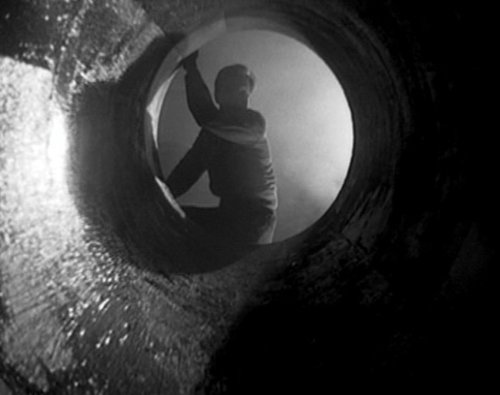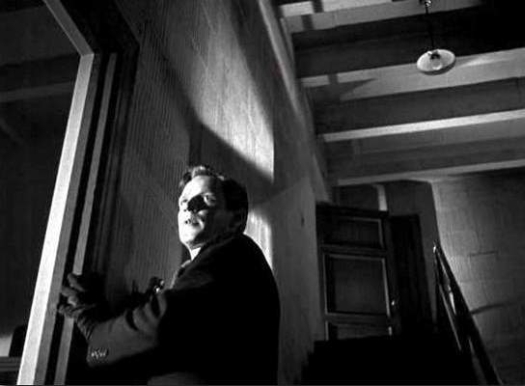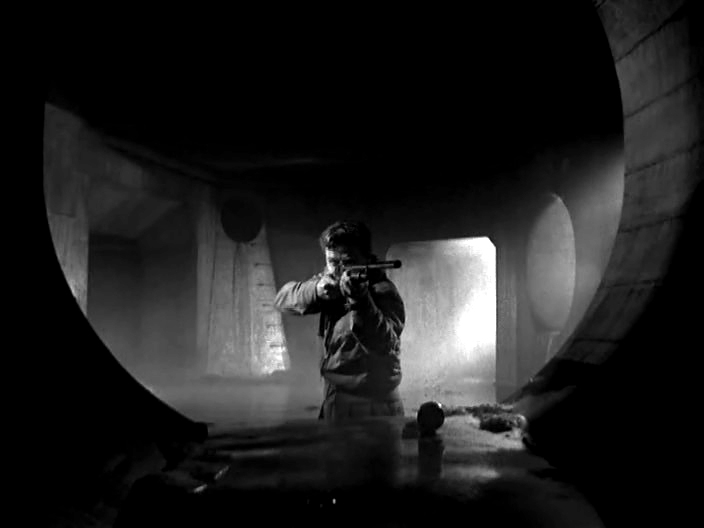Written by John C. Higgins and Crane Wilbur
Directed by Alfred L. Werker and Anthony Mann
U.S.A., 1948
The very long and arduous investigation tasked of Los Angeles police captain Breen (Roy Roberts) and Sergeant Merty Brennan (Scott Brady) begins on a quiet night, on a quiet street when aspiring criminal guru Roy Martin (Richard Basehart) is accosted by a patrolling officer after the latter sees him trying to break into an electronics shop. Roy is prepared for the confrontation, surprising the unfortunate law enforcement representative with his pistol, killing the man in the process. With one of their own gunned down mercilessly, Captain Breen and Sgt. Brennan tackle one of the most difficult cases of their careers, a story inspired by the newspaper headlines of the time when in 1945 and 1946 a former police officer and army veteran Erwin Walker took the city by storm with a series of thefts and shootings.
He Walked by Night can lumped into a very special category of film noir. As elaborated in their simply title book, Film Noir (Alain Silver, James Ursini, Film Noir, Taschen, 2004), there exists a sub-movement within noir recognized as docu-noir, wherein the filmmakers go about telling stories based on real life events (as well have German expressionism marry Italian neo-realism, but that is another discussion for another article). As stated already, the directors and screenwriters of He Walked by Night were taken by the recent killing spree of a crazed former enforcer of the law, choosing to bring the grisly tale, with certain alterations, to the silver screen in a fusion of real life facts and cinematic creative liberty. This would not be the last time studios chose to base grim, morally ambiguous and stylishly told thrillers on shocking reports that grabbed media attention. That said, the docu-noir is not the most vividly recalled of all the sub-movements contained within film noir, which is a bit strange considering that some of its most famous directors worked within those very confines, such as Anthony Mann, who had already given audiences T-Men in 1947.
As for He Walked by Night, it certainly starts off with a clear-cut indication that the motion picture is intended to function as something along the lines of a documentary. As directing duo of Mann and Werker offer viewers a series of images of the L.A.P.D. going about its usual business, a narrator gifted with an impressively strong voice, one inviting admiration from the audience, describes how efficient and important the force is. To modern eyes and ears, the opening minutes might represent a rather antiquated propaganda reel in which a talented cast and crew were tasked to produce a gushing love letter to the Los Angeles police. Thankfully, this somewhat off putting portion of the film lasts only a few minutes. Despite its dubious quality, it does serve the purpose of enveloping the audience into the world of one of the most renowned (and often reviled) policing institutions.
True to the promise of the early moments, the filmmakers do indeed invest a lot of time in portraying the minutia of detective work, some aspects being less traditionally thrilling than others. That goes with the territory however, as a detective does not have to risk his or her neck every single day in order to nab a ne’re do well. For that reason, the movie does ask for a certain level of patience out of the viewer, for the thrills do not come in as fast and furiously as in other films in which cops are on the hunt after deranged murderers. Said patience is rewarded however with some genuinely interesting scenes involving the questioning of some victims of the antagonist’s cons and another in which a group of witnesses are brought in to the police headquarters one night to help determine what Roy Martin, a man of many disguises, actually looks like via a slide show featuring an artist’s rendition of various facial features and hair styles.
As such, in addition to representing a docu-noir, He Walked by Night can just as easily be labeled a procedural given the picture’s keen interest in laying out the legwork the police must adhere to in order to locate and catch Roy. This aspect both represents one of the film’s stronger and weaker elements however. A sizeable portion of the scenes play well as snippets into the world of a LAPD detective and thanks to the great John Alton’s cinematography, much it looks very slick and well produced, particularly during a nighttime scene in which Roy attempts to sneak by the two detectives protecting a witness and the rip roaring finale involving a frantic, bullet ridden chase through the Los Angeles underground. It is interesting to note that the film was released a year before Carol Reed’s The Third Man which also features a dramatic climax beneath street level. No one is going to claim that Reed and company stole the idea from the Werker-Mann directed movie, but it is curious to note how two different films set their final, most action-packed scenes in extremely similar locations.
While such qualities are commendable, the film lacks momentum and is unsure of how to fully develop its characters. There are some lulls that put the breaks on whatever momentum the plot had built up until that point. In fact, the pacing is a bit schizophrenic, opting for an uneasy balance between sequences of well directed action and tension, followed by long stretches during which very little haste is felt. In that sense, He Walked by Night juggles its innate desire for providing the expected thrills such movies so often promise and its interest in adhering to the procedural nature its documentary-style aspiration begets. Additionally, in its quest to pay so much heed to police work, the individuals involved no longer become actual, threee-dimensional individuals. This may not feel as rash a move with respect to the protagonists. After all, so long as they possess the square jaw, tough guy looks and bulldog determination, such qualities can suffice for an audience. Where the film falters is its handling of the antagonist, the social outcast Roy Martin. Firstly, the movie reveals who he is right from the opening minutes, thus relieving much of the potential tension. Secondly, after spending so many scenes with the character, there is nary a hint as to why he is doing what he is doing. What is his end game? Why is he choosing the strategies he chooses? This doesn’t break the movie so much as it encourages a viewer to contemplate what could have been.
As it stands, He Walked by Night is fine, but it is difficult to award much more praise than that. There are definitely some missed opportunities, glaring ones at that, and it does suffer from pacing issues. On the flip side, much of it looks as inky black and evocative as the best film noir has to offer and there is some unexpected excitement to be had in witnessing the minutia of detective work. Ultimately its virtues outweigh its limitations, although seasoned viewers need not necessarily rank this too highly on their ‘must see’ list except for cinematography aficionados.
-Edgar Chaput




